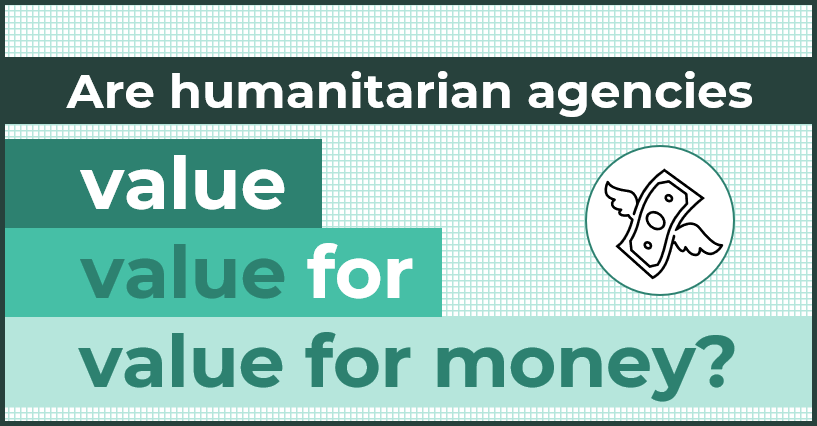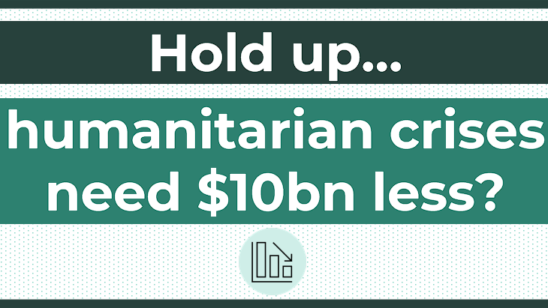
Are humanitarian agencies ‘value for money’?6 min read
The funding gap between rising humanitarian needs and shrinking donor budgets is widening, with recent efforts to present a more targeted approach to global appeals. It is debated whether the scare resources are targeted impartially to where humanitarian assistance is needed most or whether political interests make some crisis the priority and others neglected. Despite the insufficiency of humanitarian funding, though, less attention is paid towards whether resources are being used in the most optimal or cost-efficient way, including whether humanitarian agencies are value for money.
Several humanitarian organisations are currently facing some stark financial decisions. The World Food Programme is in the midst of an unprecedented funding crisis that is forcing it to cut programmes as the number of food insecure globally increases and the money required to feed them declines. At least 38 of WFP’s 86 country operations have experienced reductions. The International Committee of the Red Cross likewise cut its annual budget by 13 per cent this year after an even bigger deficit last year which forced it to close several of its country operations around the world.
And yet there is currently no system-wide approach for deciding how resources should be best spent or standardised way of assessing whether humanitarian agencies provide value for money.
No common measure for value for money
Broadly speaking ‘value of money’ refers to whether resources are used in the best way to achieve desired outcomes to meet the needs of beneficiaries. It is a combination of cost and quality. Humanitarian agencies are in the business of ‘saving lives’ so it is hard to put a price on what they do, let alone trade off different outcomes for how money is spent to save the greatest number of lives. More attention has, therefore, been placed on the quality of humanitarian assistance, with various initiatives developed to promote system-wide standards to which agencies are encouraged to sign up.
Whether more lives could be saved with less money should, though, be a concern for all humanitarians. However, aid agency performance is more likely to be measured by the effectiveness in reaching planned results rather than the efficiency of humanitarian aid, which is a more contested and sensitive measure of success. Cost efficiency is poorly evidenced and agencies disclose limited information about how funds are spent and how costs are managed. In humanitarian evaluations ‘efficiency’ is more likely to be assessed by the perception of stakeholders than it is through an analysis of actual cost measures.
The 2016 Grand Bargain brought increased attention to the effectiveness and efficiency of humanitarian aid, with signatories making a diverse set of commitments on a range of issues. Over time, however, priorities have changed with the latest iteration of the initiative focusing on just two issues – the quality of funding and localisation, albeit with mixed results. Despite the initial goals of the Grand Bargain, ‘value for money’ has never explicitly been discussed by the signatory agencies.
It is an indicator in the Multilateral Organization Performance Assessment Framework (MOPAN) which is a network of member states that conducts organizational assessments of UN agencies. Having personally led one of these assessments, though, there is usually a death of evidence to measure performance for this indicator, which remains somewhat subjective. The Independent Aid Commission for Aid Impact scrutinises UK aid spending so that it is spent effectively and delivers value for UN taxpayer. Other donors clearly have the same concerns, but there is no system-wide methodology for how the value of humanitarian assistance should be assessed.
Ways to assess whether humanitarian funds are being spent well
Figures for cost-per-output or cost-per-beneficiary are not systematically included in humanitarian project proposals so it is hard to tell whether funds are being used in the most optimal way to achieve the greatest results, with the least amount of money. There is rarely a discussion about whether one programme intervention is going to be a better use of money than another.
There has been a lot of effort to ensure that humanitarian appeals do not present inflated financial requirements. The Humanitarian Programme Cycle that generates these response plans includes detailed costing methodologies, but agencies are not required to present cost-benefit analysis that demonstrates that funds will be used in the most efficient way and provide value for money.
There have been developments in humanitarian action that are driving down costs such as the increasing use of cash assistance. The drive towards local procurement is making humanitarian supplies cheaper. The digitalisation of aid has presented both challenges and opportunities. At the same time security and access constraints are making humanitarian action more expensive with agencies forced to invest more in risk management to protect staff and assets, and mitigate the potential for funds being misused.
Much to the chagrin of aid workers they frequently complain about spending more time in coordination meetings and writing donor proposals and reports, than delivering aid. With the expansion of the humanitarian system to meet rising needs there is concern that it is becoming more bureaucratic and less efficient.
As operating costs increase less money is making it to the intended beneficiaries. Recent research shows that staff costs of the largest agencies are increasing while the proportion of funds going from some UN agencies to their implementing partners is actually decreasing.
Little wonder then that concerns about the lack of progress with the localisation of aid persist, with the proportion of humanitarian funding received by local actors being a poultry 1.2 per cent in 2022. Efforts have been made recently to ensure that at least a fair amount of funding goes on the overheads of local actors.
The proliferation of different humanitarian funds on a range of topics has helped mobilise resources and address neglected issues but they also include additional transactional costs as funds are passed through multiple agencies, each taking their cut, before reaching the intended recipient beneficiaries. Organisations such as Give Directly are now marketing themselves as being able to assist people with the least operational costs.
We don’t know, but we should
There are then a range of factors that influence whether humanitarian funding is being used in the more efficient and optimal way. The aim of this article has not been to argue that humanitarian agencies are not value for money. We simply don’t know as this kind of information is not routinely collected or analysed, with a distinct lack of transparency. While efficiency is an implicit consideration for humanitarian agencies there is no system-wide measure for this, nor explicit obligation to demonstrate value for money. In many ways the issue remains a taboo in humanitarian circles, with a sense that the ends justice the means of humanitarian action, with a reluctance to scrutinise interventions on whether they represent value for money.
Given the alarming state of humanitarian funding this is an issue that the humanitarian system cannot ignore. As a start a common definition of value for money for humanitarian action and means for measuring this across projects, plans and appeals should be developed. Donors should establish independent regulatory bodies to assess whether their tax-payers money is being spent well on humanitarian action. Guidance should be developed for agencies to be more transparent about how they are using their funding and reporting on indicators linked to value for money. Only by taking this issue seriously and adopting required measures will we know that we are doing the most to protect and save lives of the increasing number of crisis-affected people globally.


